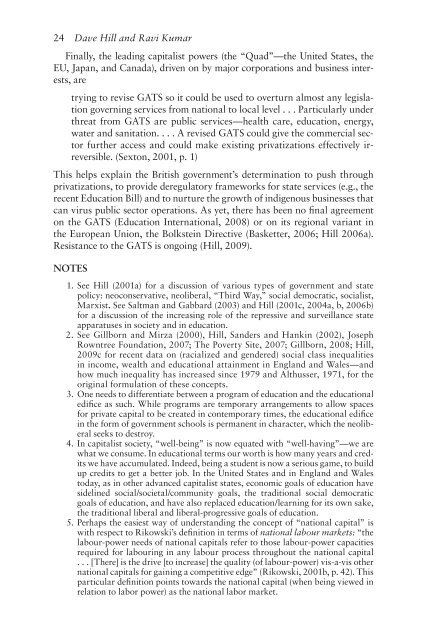NEOLIBERALISM Global neoliberalism and education and its consequences
NEOLIBERALISM Global neoliberalism and education and its consequences
NEOLIBERALISM Global neoliberalism and education and its consequences
You also want an ePaper? Increase the reach of your titles
YUMPU automatically turns print PDFs into web optimized ePapers that Google loves.
24 Dave Hill <strong>and</strong> Ravi KumarFinally, the leading capitalist powers (the “Quad”—the United States, theEU, Japan, <strong>and</strong> Canada), driven on by major corporations <strong>and</strong> business interests,aretrying to revise GATS so it could be used to overturn almost any legislationgoverning services from national to local level . . . Particularly underthreat from GATS are public services—health care, <strong>education</strong>, energy,water <strong>and</strong> sanitation. . . . A revised GATS could give the commercial sectorfurther access <strong>and</strong> could make existing privatizations effectively irreversible.(Sexton, 2001, p. 1)This helps explain the British government’s determination to push throughprivatizations, to provide deregulatory frameworks for state services (e.g., therecent Education Bill) <strong>and</strong> to nurture the growth of indigenous businesses thatcan virus public sector operations. As yet, there has been no final agreementon the GATS (Education International, 2008) or on <strong>its</strong> regional variant inthe European Union, the Bolkstein Directive (Basketter, 2006; Hill 2006a).Resistance to the GATS is ongoing (Hill, 2009).NOTES1. See Hill (2001a) for a discussion of various types of government <strong>and</strong> statepolicy: neoconservative, neoliberal, “Third Way,” social democratic, socialist,Marxist. See Saltman <strong>and</strong> Gabbard (2003) <strong>and</strong> Hill (2001c, 2004a, b, 2006b)for a discussion of the increasing role of the repressive <strong>and</strong> surveillance stateapparatuses in society <strong>and</strong> in <strong>education</strong>.2. See Gillborn <strong>and</strong> Mirza (2000), Hill, S<strong>and</strong>ers <strong>and</strong> Hankin (2002), JosephRowntree Foundation, 2007; The Poverty Site, 2007; Gillborn, 2008; Hill,2009c for recent data on (racialized <strong>and</strong> gendered) social class inequalitiesin income, wealth <strong>and</strong> <strong>education</strong>al attainment in Engl<strong>and</strong> <strong>and</strong> Wales—<strong>and</strong>how much inequality has increased since 1979 <strong>and</strong> Althusser, 1971, for theoriginal formulation of these concepts.3. One needs to differentiate between a program of <strong>education</strong> <strong>and</strong> the <strong>education</strong>aledifice as such. While programs are temporary arrangements to allow spacesfor private capital to be created in contemporary times, the <strong>education</strong>al edificein the form of government schools is permanent in character, which the neoliberalseeks to destroy.4. In capitalist society, “well-being” is now equated with “well-having”—we arewhat we consume. In <strong>education</strong>al terms our worth is how many years <strong>and</strong> cred<strong>its</strong>we have accumulated. Indeed, being a student is now a serious game, to buildup cred<strong>its</strong> to get a better job. In the United States <strong>and</strong> in Engl<strong>and</strong> <strong>and</strong> Walestoday, as in other advanced capitalist states, economic goals of <strong>education</strong> havesidelined social/societal/community goals, the traditional social democraticgoals of <strong>education</strong>, <strong>and</strong> have also replaced <strong>education</strong>/learning for <strong>its</strong> own sake,the traditional liberal <strong>and</strong> liberal-progressive goals of <strong>education</strong>.5. Perhaps the easiest way of underst<strong>and</strong>ing the concept of “national capital” iswith respect to Rikowski’s definition in terms of national labour markets: “thelabour-power needs of national capitals refer to those labour-power capacitiesrequired for labouring in any labour process throughout the national capital. . . [There] is the drive [to increase] the quality (of labour-power) vis-a-vis othernational capitals for gaining a competitive edge” (Rikowski, 2001b, p. 42). Thisparticular definition points towards the national capital (when being viewed inrelation to labor power) as the national labor market.












